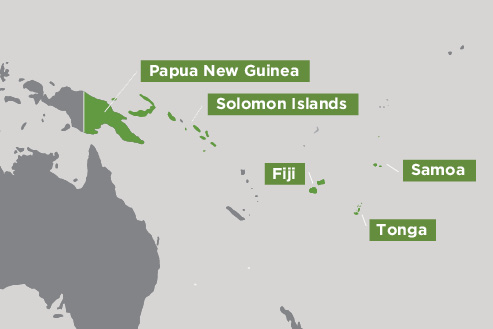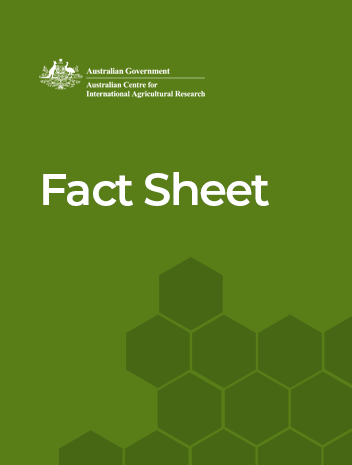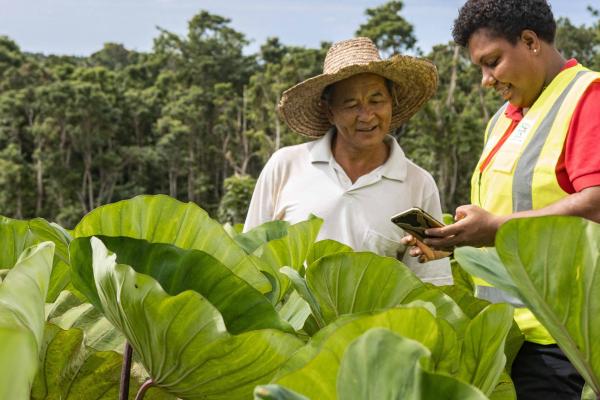Overview
This project aims to develop integrated pest and disease management strategies for the sustainable intensification of fruit and vegetable crop production, addressing the threats posed by the inappropriate use of pesticides, emerging pests and diseases and climate change.
The development of high-value fruit and vegetable crops for both domestic consumption and export is considered a priority for economic development and improved livelihoods in many Pacific Island countries.
This project builds on the gains and success made in the previous ACIAR project HORT-2010-090 from 2017. In doing so, it aims to address the increased incidence and severity of pests and diseases throughout the Pacific islands due to accidental incursion and/or environmental change. This will in turn contribute to the broader development goal of improving the livelihoods of smallholders and their communities in the Pacific islands.
Expected project outcomes
- Building diagnostic and strategic planning capacity for integrated pest and disease management, including biological control.
- Developing (and, where possible, implement) biological control strategies for invasive and emergent pests of selected crops and cropping systems.
- Extending integrated pest and disease management and insecticide resistance management strategies to additional cropping systems.
Summary of outcomes to date
2021-22
- Project advisory group (PAG) established. Face to face meetings not possible but 40 project meetings (1-1.5 h) held weekly/ bi-weekly by Zoom in the reporting period.
- PHC training manual, “Plant Health Clinics: a Training Manual for Plant Health Doctors in Pacific Island countries” was published by SPC in December 2021. Initial print run of 1000 copies distributed to partner countries
- Regional plant health clinic (PHC) training team established and online and local training of trainers. Online training has utilised the CABI Academy training modules (Plant Pest Diagnosis and Plant Pest Management) and licences have been purchased for the regional and national trainers. Further hybrid (face-to-face and online) involving all countries undertaken
- Version 11 of the Pacific Pests, Pathogens and Weeds mobile app (534 factsheets) published July 2021.
- FNU has developed a compulsory undergraduate course dedicated to PHCs as part of its BAg curriculum. All BAg students will take the course from 2023.
- PHC manual is also used in plant protection courses at Solomon Island National University (SINU), and The University of the South Pacific (USP). At both institutions, curricula have been co-developed to include PHCs.
- Pest surveillance focused on Asian Citrus Psyllid in Samoa, Fall Armyworm in PNG, Solomon Islands, Fiji and Vanuatu and coconut rhinoceros beetle (CRB) in all countries. In Samoa ACP is well established (Upolu and Savai’i) but Candidatus Liberibacter asiaticus remains undetected in insects. CRB is prevalent in all countries. Fall Armyworm (hybrids of corn and rice strains) is distributed over all PNG Provinces, and in July 2021 it was detected in Solomon Islands (Guadalcanal). No evidence of FAW movement into other project countries at this stage
- In response to requests by collaborating countries, the haplotypes of CRB have been investigated in Fiji, Samoa, Tonga and Solomon Islands and the incidence of the nudivirus (OrNv) in these populations determined. This large body of work shows:
- There are three major mitochondrial haplotype lineages (CRB-G, a PNG lineage (CRB-PNG) and the South Pacific lineage (CRB-S)) across the region.
- Haplotype diversity varies between and within countries. In most countries CRB is monotypic and all individuals tested belonged to a single mitochondrial lineage (Fiji, CRB-S; Tonga, CRB-S; PNG (Kimbe), CRB-PNG).
- In Samoa CRB-S and CRB-PNG detected and in Solomon Islands all three haplotypes found (evidence for genetic admixture between CRB-G and CRB-PNG).
- Recent CRB invasions into New Caledonia and Vanuatu belonged to the CRB-G and CRB-PNG haplotypes respectively.
- A high incidence of OrNV detected in all haplotypes, wherever they were found.
- The genetic responses of the CRB-G haplotypes from Solomon Islands and the Philippines (CRB-G) to OrNV infection were different.
- OrNV infection induced antimicrobial and immune responses in all CRB haplotypes, but the direction and magnitude of the responses were population specific. Insects from Solomon Islands displayed extremely high expression of immune response genes. These variations in the host immune system among insects from different geographical regions might be driven by variations in the virulence of OrNV isolates and this requires further investigation.
- The project team recently published the nuclear genome of CRB, and it is being investigated to determine the genetic relationships between CRB populations from across the region. This will contribute to our understanding of the origins of the CRB incursions that have occurred in recent years.
- In addition to the requested CRB research, countries identified biological control research and implementation priorities as: Fiji, Icerya seychellarum; Samoa, D. citri and large cabbage moth; Tonga, pink wax scale and white peach scale; Solomon Islands, CRB.
- Insecticides that are compatible with IPM for diamondback moth (DBM) imported into PNG and Spinosad and Bt-k has been imported into Fiji, both have been field tested and registered for sale.
- Testing for insecticide resistance in DBM in (2021) showed that selected DBM field populations previously demonstrating resistance to some insecticides were continuing to increase in susceptibility to the IPM compatible insecticides recommended for sustainable management. Several awareness meetings, where a revised IRM strategy based on the availability of extra IPM compatible products in Fiji, have been held in farming communities.
- A book and seven papers published/ submitted for publication in the reporting period.







